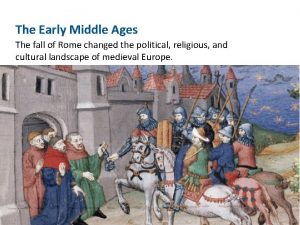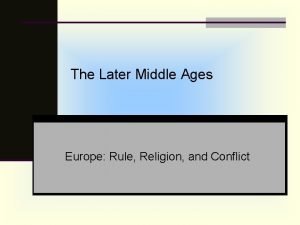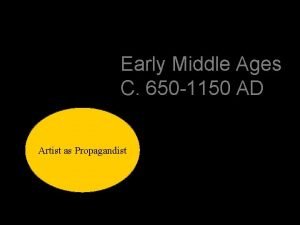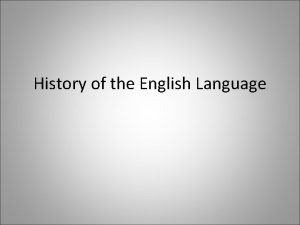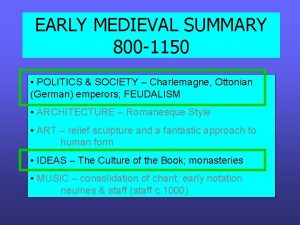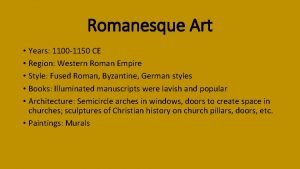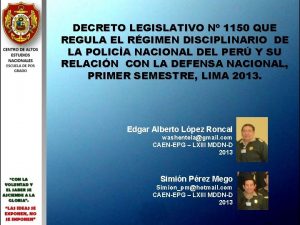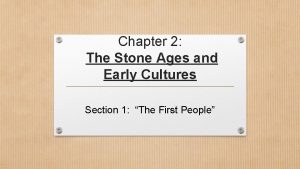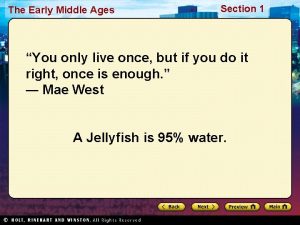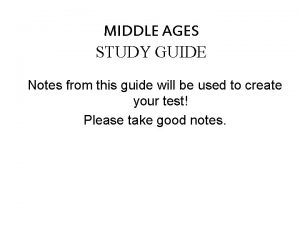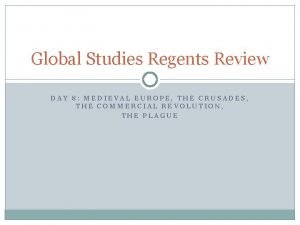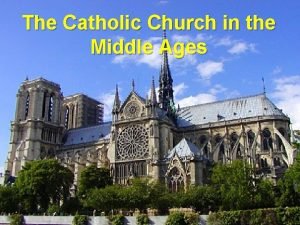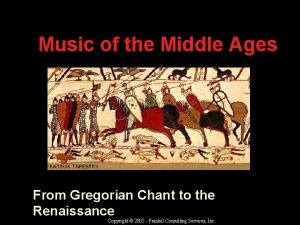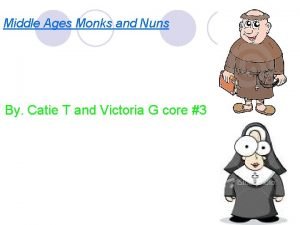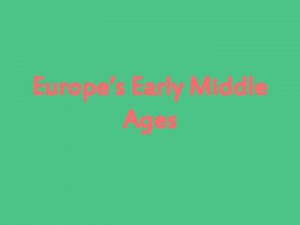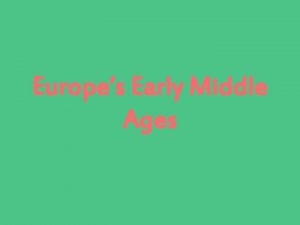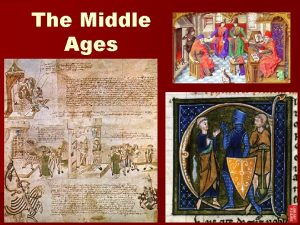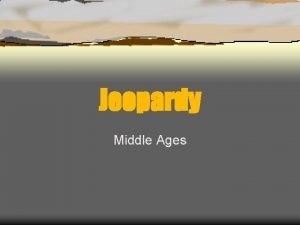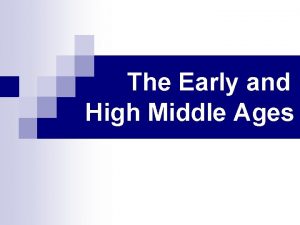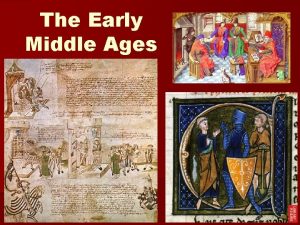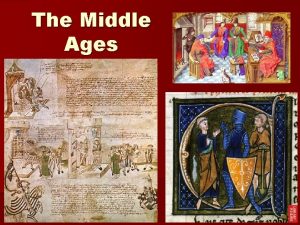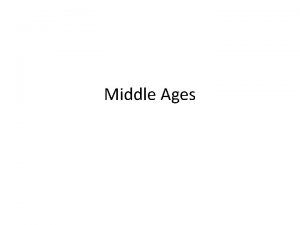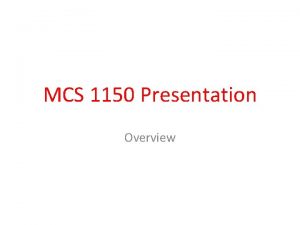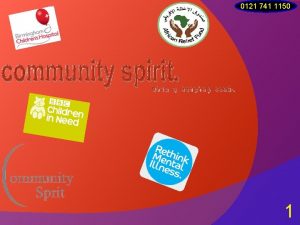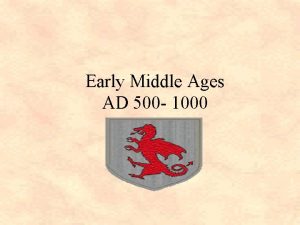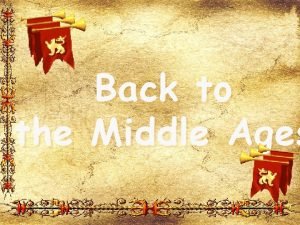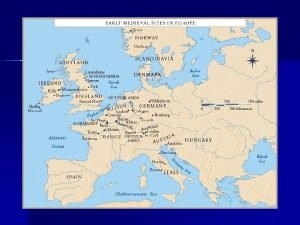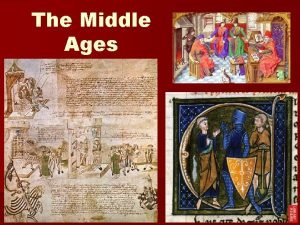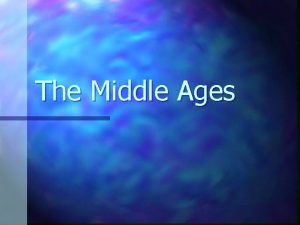Early Middle Ages C 650 1150 AD Artist





















- Slides: 21

Early Middle Ages C. 650 -1150 AD Artist as Propagandist

New Vocabulary: Enamel Westwork Narthex transcept Choir Apse Crypt Psalter

• “The Dark Ages”- period between classical antiquity and its rebirth (the Renaissance) • 650 -750 - the center of civilization moved northward into Northern/Western Europe • Artwork was portable at first due to movement of the people • Decorative animal motifs prevailed • Metalwork was principle medium- small objects translated into wood, stone, manuscript illustration

• Celtic-Germanic Style • Animal style- Germanic tribes that entered Western Europe during the declining years of the Roman Empire brought artistic traditions with themfrom Iran and Scythian Gold • Made of gold and enamel • Four pairs of symmetrical motifs- man between fighting animals- this is a popular motif in early Christian Art Purse Cover, 625 -33 AD

• Details are realistic but surface is covered with lacy ornamentation • Used to endow Viking ships with character of mythical sea dragons Animal Head, from Oseberg Ship-Burial c. 825 AD

Cross Page from Lindisfarne Gospels, c. 700 AD • Hiberno-Saxon Style • Earliest Christian works made north of the alps • Irish (Hiberians) assumed the spiritual and cultural leadership in Western Europe • “The Golden Age of Ireland”-never became part of the Roman Empire • Converted to Christianity by missionaries but were never Rome-centered • Hermits living in countryside formed first monastaries-these became centers of learning and the arts, missionaries spread Christianity over Scotland, France, Netherlands • Manuscripts used to spread the Gospelmonks produced them in large numbers • Word of God was looked upon as sacred object with visual beauty- more decorative than narrative • Precise and maze-like- followed strict rules

• Human figure was beyond the Celtic or Germanic artist’s reach • Cannot view human figure as an organic form- overcome with decoration Crucifixion, plaque from a book cover, 8 th C. AD

Carolingian Art- • Charlemagne’s empire split into 3 parts by his grandsons- political power held by local nobility • Collection and copying of ancient Roman texts-an attempt to restore classics so they could link themselves to Roman empire • Palace Chapel Aachen (capital for Charlemagne) based on S. Vitale- tried to recreate the Justinian Era • Much harder to create on Northern soil-columns and bronze were imported • Designed by Odo of Metz- earliest known architect north of the Alps • Not as fluid as Byzantine- more compartmentalized • Has a monumental entrance called a westwork- a two-tower façade that will become common in Medieval churches Palace Chape at Aachen, 792 -805 AD

Cutaway drawing of the same

• St. Riquier- has been completely destroyed but pictures remain • More elaborate westwork • Leads into a vaulted Narthex • Separated from eastern transcept by a compartment known as the choir Abbey Church of St. Riquier, 799 AD

• Important document of the time period, shows the importance of the monastery • Plan of a basic monastery agreed upon by central council that could be modified to local needs • Complex structure that emphasized the church as central to the plan • Church plan is unique to the monastery system- to fit the needs of the monks rather than the public • No monastery fits this plan, but it serves as a guide Plan of a Monastery, St. Gall, 820 AD

Redrawn so its more understandable

• Gospel books of Charlemagne have survived in great numbers • St. Matthew- very classical style except for the halo • Monks were very knowledgeable about Roman style of painting Gospel Book of Charlemagne, c. 800 -10 AD

• Utrecht Psalter- entire book is illustrated with pen drawings • Architecture, landscapes are very Roman, but very rhythmic rather than static Utrecht Psalter, 820 -32 AD

• Classical style translated into Carolingian terms • Entire picture has intense energy and motion • “the frenzy of divine inspiration” • Gazes on the symbol of St. Mark, the winged Lion- the divine St. Mark, Gospel Book 816 -35 AD

• Celtic-Germanic metalwork tradition • Crucified Christ shows no pain- had not endowed him with human suffering yet (this will come later in medieval art) The Lindau Gospels, c. 870 AD

Ottonian Art • 870 AD -remains of Charlemagne’s empire was ruled by two grandsons who ruled France and Germany. Europe was weak and exposed to attack • Normandy section of France raided by Norsemen (Danes and Norwegians) • Adopted Christianity and from 911 on, leaders were recognized as dukes subject to king of France-they became an important political force • Germany- power shifted north to Saxony- King was Otto I-extended rule over most of Italy and was crowned emperor by the Pope

• Germany led nations politically and artistically • Gero Crucifix at cathedral at Cologne • Image of Christ that was new to Western art- that of the savior (Christ died for sins of humans)-concerned with the human suffering of Christ • Physical strain and mask of agony seen here • Realistic depiction of pain, but not really gravity (he’s kind of floating rather than hanging) The Gero Crucifix, 975 -1000 AD

Plan, Hildesheim Cathedral, 1001 -33 • Similar to St. Michaels but much more symmetrical • Has a harmonious balance between longitudinal and transverse axes

• Nave is majestic and spatial • Introduction of a crypt beneath the choir- usually housed the tomb of a saint Hildesheim Cathedral, 1001 -33

Gospel Book of Otto III • Echoes of ancient art-pastel background similar to Roman landscapes • Architectural scenes are now churches • Figures look very different- Christ is seen as clean-shaven (Roman tradition) • Emphasis has shifted from physical to spiritual action • Christ and Peter are larger than the rest, disciples are crushed together Christ Washing The Feet of Peter, from the Gospel Book of Otto III c. 1000 AD
 Renaissance vs medieval art
Renaissance vs medieval art Why are the middle ages called the dark ages
Why are the middle ages called the dark ages Early middle ages
Early middle ages Early middle ages
Early middle ages 1150 ad
1150 ad Old english (450-1150)
Old english (450-1150) 800-1150
800-1150 Wmo 1150
Wmo 1150 Sudut 100
Sudut 100 1150 ce
1150 ce Decreto legislativo 1150
Decreto legislativo 1150 The stone ages and early cultures
The stone ages and early cultures Chapter 7 early childhood ages 3 through 5
Chapter 7 early childhood ages 3 through 5 Middle ages nobles
Middle ages nobles The middle ages outcome the power of the church
The middle ages outcome the power of the church Middle ages study guide
Middle ages study guide Middle ages regents questions
Middle ages regents questions What does rebirth mean
What does rebirth mean Middle ages
Middle ages Gregorian chant composers
Gregorian chant composers Middle ages
Middle ages Nuns in the middle ages
Nuns in the middle ages


